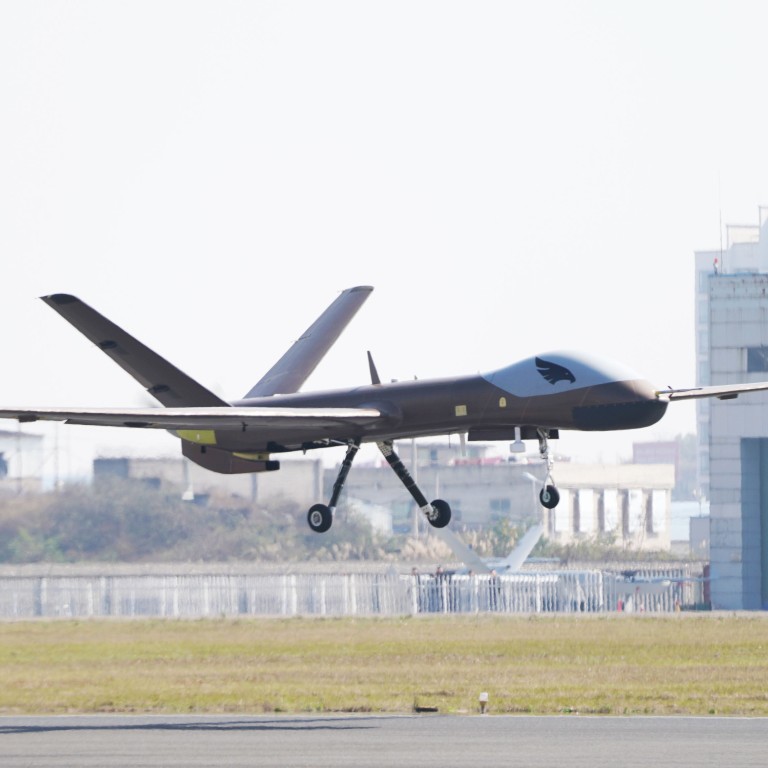
Could China’s new combat drone be a rival to the US Army’s Grey Eagle?
- Photos from Wing Loong-1E’s first flight show it has similar features to the American drone, which was designed for surveillance and precision strikes
- According to military researcher, engine technology is still an issue for Chinese unmanned aircraft – though they are competitively priced
After the Wing Loong-1E’s test flight on January 18, Aviation Industry Corporation of China (Avic) said the new drone would “give wings to the Chinese unmanned combat aerial vehicle [UCAV] family”.
State media highlighted the development, with broadcaster CCTV saying the multi-purpose drone met advanced international standards and had been “optimised and upgraded based on the proven technologies of its predecessors”.
Official newspaper China Daily said the new design aimed to compete with the MQ-1C Grey Eagle, citing a statement from the Avic subsidiary behind the Wing Loong-1E, Chengdu Unmanned Aerial Vehicle System.
A medium-altitude, long-endurance unmanned aircraft, the MQ-1C Grey Eagle was developed by General Atomics Aeronautical Systems for the US Army. It has endurance of 25 hours, can operate at up to 8,800 metres (29,000 feet) and has a total payload capacity of 488kg (more than 1,000 pounds).

Avic did not provide details of the Wing Loong-1E, but said it was bigger than the previous model, the Wing Loong-1. That drone has endurance of 20 hours, a service ceiling of 5,000 metres and a total payload of 200kg.
Photos released from the maiden flight show the new drone is equipped with similar features to the MQ 1-C Grey Eagle, which was designed for surveillance and precision strikes. They include a laser designation system, synthetic aperture radar and communication relay capabilities.
But the engine technology is still an issue, according to Zhou Chenming, a researcher with the Yuan Wang military science and technology institute in Beijing.
“Chinese drone developers have been unable to catch up to the MQ-1C and other American combat drones in terms of endurance and payload because of the gap in engine technology,” Zhou said. “But Chinese drones are still very competitive [in the global market] because of their cheaper prices.”
The Wing Loong-1 is about a quarter of the cost of the MQ-1C Grey Eagle, whose price tag is more than US$31 million, according to Chinese state media reports.
How drones became the new front in the US-China tech war
In the past decade, Chinese companies have delivered 220 UCAVs to 16 countries, mainly in the Middle East and Africa, according to reports by the Stockholm International Peace Research Institute.
Buyers include Nigeria, Egypt and the United Arab Emirates – all of whom import other weapons from the United States, SIPRI said. They were unable to buy military drones from the US until 2018, when former leader Donald Trump loosened a policy on arms sales to foreign governments, but it is unclear if they will make the shift away from the cheaper Chinese unmanned aircraft.
In addition to its military drones, Avic has also developed several civilian models – based on the Wing Loong-2 and Wing Loong-10 combat drones – for use in emergency response situations, communication relay, weather forecasting and for other public service operations.
Like the US MQ-1C Grey Eagle, all of the Wing Loong drones have an automatic take-off and landing system, meaning they can be launched and recovered without any operator interaction.
Other Chinese armed drones being sold to overseas buyers include the Caihong (Rainbow) series, developed by the China Aerospace Science and Technology Corporation. These UCAVs, which can launch lethal strikes, have reportedly been seen across the Middle East and Africa, including in Egypt, Libya, Nigeria and Yemen.
Macau-based military analyst Antony Wong Tong said Chinese drones were popular in both regions, and not just because they were cheaper than others.
“There’s another selling point: Beijing doesn’t care about how these weapons are going to be used,” Wong said, adding that Chinese manufacturers of armed drones were willing to export them to almost anyone.
“That’s why you can see some countries using Chinese weapons to fight each other,” he said.

